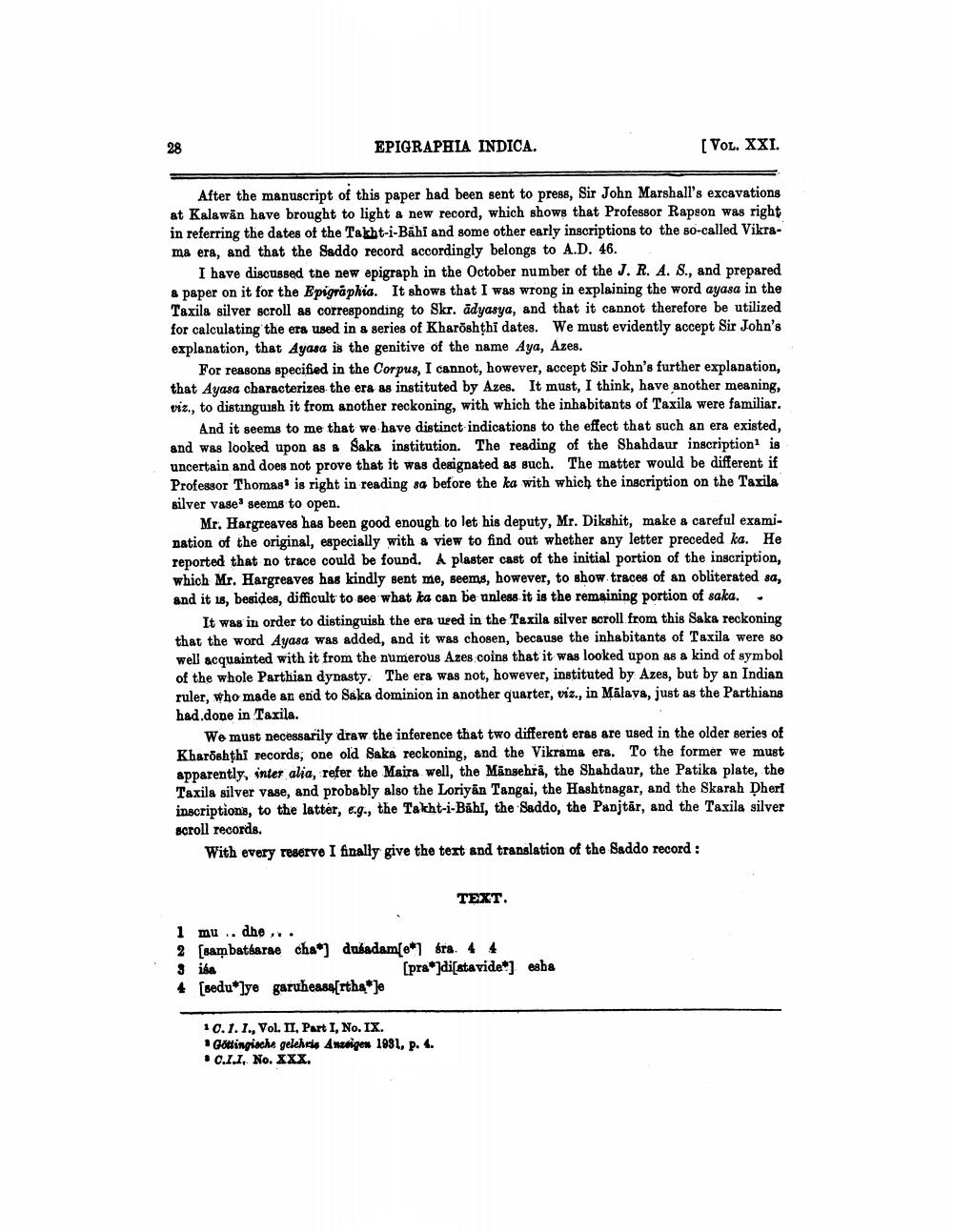________________
28
EPIGRAPHIA INDICA.
After the manuscript of this paper had been sent to press, Sir John Marshall's excavations at Kalawan have brought to light a new record, which shows that Professor Rapson was right in referring the dates of the Takht-i-Bahi and some other early inscriptions to the so-called Vikrama era, and that the Saddo record accordingly belongs to A.D. 46.
I have discussed the new epigraph in the October number of the J. R. A. S., and prepared a paper on it for the Epigraphia. It shows that I was wrong in explaining the word ayasa in the Taxila silver scroll as corresponding to Skr. adyasya, and that it cannot therefore be utilized for calculating the era used in a series of Kharöshṭhi dates. We must evidently accept Sir John's explanation, that Ayasa is the genitive of the name Aya, Azes.
For reasons specified in the Corpus, I cannot, however, accept Sir John's further explanation, that Ayasa characterizes the era as instituted by Azes. It must, I think, have another meaning, viz., to distinguish it from another reckoning, with which the inhabitants of Taxila were familiar.
And it seems to me that we have distinct indications to the effect that such an era existed, and was looked upon as a Saka institution. The reading of the Shahdaur inscription is uncertain and does not prove that it was designated as such. The matter would be different if Professor Thomas is right in reading sa before the ka with which the inscription on the Taxila silver vase seems to open.
[VOL. XXI.
Mr. Hargreaves has been good enough to let his deputy, Mr. Dikshit, make a careful examination of the original, especially with a view to find out whether any letter preceded ka. He reported that no trace could be found. A plaster cast of the initial portion of the inscription, which Mr. Hargreaves has kindly sent me, seems, however, to show traces of an obliterated sa, and it is, besides, difficult to see what ka can be unless it is the remaining portion of saka..
It was in order to distinguish the era ured in the Taxila silver scroll from this Saka reckoning that the word Ayasa was added, and it was chosen, because the inhabitants of Taxila were so well acquainted with it from the numerous Azes coins that it was looked upon as a kind of symbol of the whole Parthian dynasty. The era was not, however, instituted by Azes, but by an Indian ruler, who made an end to Saka dominion in another quarter, viz., in Mälava, just as the Parthians had.done in Taxila.
We must necessarily draw the inference that two different eras are used in the older series of Kharoshthi records; one old Saka reckoning, and the Vikrama era. To the former we must apparently, inter alia, refer the Maira well, the Mansehra, the Shahdaur, the Patika plate, the Taxila silver vase, and probably also the Loriyan Tangai, the Hashtnagar, and the Skarah Dherl inscriptions, to the latter, e.g., the Takht-i-Bahl, the Saddo, the Panjtar, and the Taxila silver scroll records.
With every reserve I finally give the text and translation of the Saddo record:
1 mu
dhe...
2 [sambatsarae cha*] dušadam[e*] śra. 4 4
3 isa
4 [sedu lye garuheasa[rtha")
TEXT.
[pra*]di[stavide*] esha
10.1. I., Vol. II, Part I, No. IX.
Göttingische gelehris Anzeigen 1931, p. 4. C.I.I. No. XXX.




